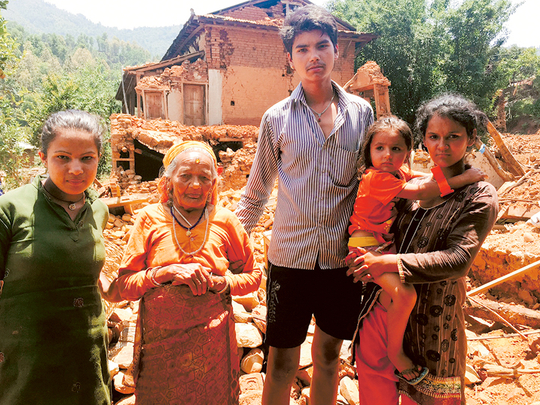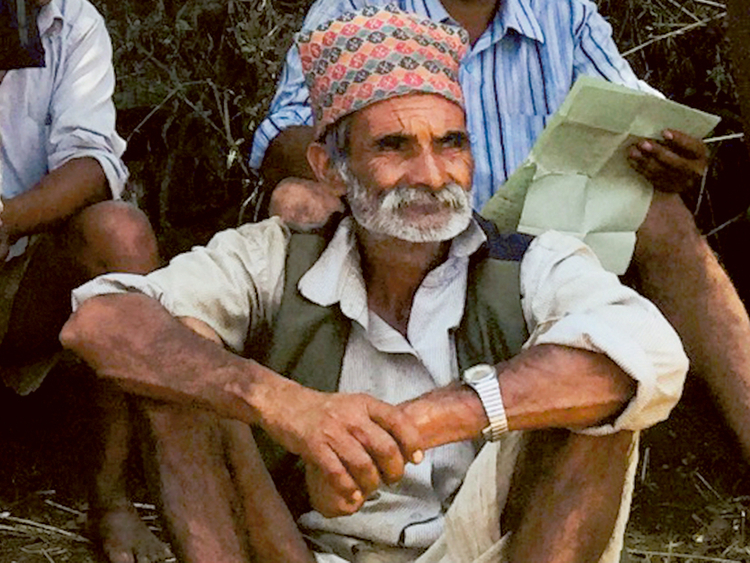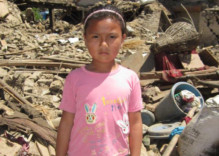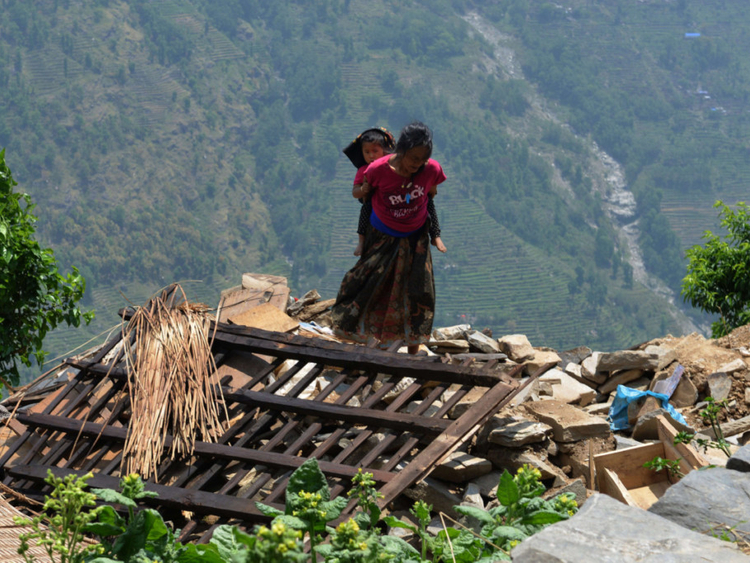
It is seven in the morning. The first rays of sunshine have landed on the rugged mountains overlooking a cluster of villages that are already awake.
There is a slow trickle of people up a steep road leading to a patch of flat ground. Men, women and children with scruffy hair and tattered clothes huddle in groups — their weary eyes planted firmly on the jerky approach road downhill.
In the ruins scattered around them are their lives and livelihoods. The 7.8 magnitude earthquake that jolted Nepal on April 25 has wiped out most of Sindhupalchok district, reducing its rustic, impoverished villages to heaps of rubble. More than 3,500 people died here.
Syuale is no different. There is nothing left of this village of 13,000 people. Heaps of mud and pounded stones lie where their mud houses once stood. Broken, helpless and homeless — they are waiting.
It has been more than a month since the killer quake struck. People here are still without a roof over their heads. Only a lucky few have managed to prop up temporary sheds with plastic sheets and asbestos salvaged from their collapsed houses.
A little after 11am, a small fleet of trucks trundles along the jagged road, kicking up clouds of red dust from pulverised bricks. Hope rises above the muddy haze, and there is a commotion.
Plan International, an NGO, has set up 13 distribution points at Sindhupalchok to distribute aid. Their volunteers get off the vehicles and start distributing tarpaulins to each of the families. Clutching the thick yellow packet, people start heading back — their homes in their hands.
“It has been a month now and we have not received any help from the government. Our women and children are sleeping in the open air,” said Harikumar Shresht, 38.
He lost his house, and his cattle also perished under the rubble. The family of seven has been surviving on an aid food packet delivered by a local NGO two days after the quake. Shresht does not know how long it can feed their hungry stomachs. But he is grateful for the tarpaulin that will shelter him in the rain.
Chandrababu, another local, lost three of his family members. He said he dug them out with his bare hands from under the debris. “How long could we wait for help? It is our people who were trapped inside.”
Thousands of Nepal’s villages were obliterated and an estimated 800,000 Nepalese were rendered homeless in one of the worst natural disasters to hit this Himalayan country in 80 years.
Thirty-two districts — including Dolakha, Kavre, Sindhupalchok, Kathmandu, Lalitpur, Bhaktapur, Nuwakot, Dhading and Gorkha — were badly affected. The death toll crossed 8,000 and more than 14,000 people were injured.
In a tragic replay, a second earthquake of 7.3 magnitude rattled Nepal on May 12 in the foothills of Himalayas, killing at least 60 more people and injuring 1,129. Hundreds of buildings weakened in the first quake, collapsed, pushing hundreds more into the streets.
Lack of temporary shelters
In a statement, the UN said nearly 8 million of Nepal’s 28 million people had been affected by the quake, and two million are in need of tents, water, food and medicines over the next three weeks.
Deputy Prime Minister Prakash Man Singh said the country urgently needs at least one million tents to provide temporary shelter to thousands of victims. According to the government, the earthquake has destroyed more than 300,000 houses.
But an acute shortage of tents and tarpaulins is hitting the relief and rehabilitation efforts. Sagar Mani Parajuli, joint secretary in the Home Ministry, Nepal, said the biggest challenge facing the government is to reach the remote pockets where aid is badly needed. “Our priority is to give temporary shelters to affected families. But the demand is so high we are struggling to meet the numbers,” said Parajuli.
Local authorities working with Village Development Committees (VDCs) have demanded 600,000 tents. As supply from local markets has dried up, suppliers are sourcing tents from India and China.
Both the government and international charitable organisations are racing against time to reach out to the victims before the monsoon season begins in less than two weeks. Aid agencies have already warned the full-blown disaster can unleash a medical and humanitarian catastrophe, with thousands living in the open air without access to clean water, medicine and sanitation.
But one month on, life is still paralysed. The limp back to normalcy is excruciatingly slow and painful in most of the affected areas.
In the rural villages bordering Kavre and Bhaktapur, which witnessed massive devastation, people still live in fear of the impending monsoon and landslides. Belonging to the most backward communities of Tamang, Magar or Gurung, these villagers have lost their loved ones, belongings and source of income.
“I have no hope I will live to see things getting better in my village,” says Kedarprasad Nepal, 71, of Chandeni Mandan Village. “I think I will breathe my last under this tarpaulin.” His son, like many others in the villages, is working in one of the Gulf countries, and there is no one to rebuild the houses.
Another local, Vasudev Nepal, 64, said, “I don’t know how we will survive this monsoon. We have no food, shelter or clothing.” His family of 11 is living in a makeshift asbestos shelter on the sides of a dust-choked road where his village once stood. A few kilograms of rice, lentils, and salt distributed by the UN World Food Programme volunteers are what most of the families have for the next few weeks.
Access to these far-flung hilly villages is difficult, and the roads winding over the mountains are treacherous. Many roads remain cut off due to landslides triggered by the earthquake, making it even more difficult for aid to arrive.
In the nearby Banthali village, the only medical clinic was destroyed in the quake, and the closest hospital is two hours away. Sharmila Kanthitar, 32, is seven months pregnant, and she is worried about her baby. “I have seen people dying under the rubble. I want my baby to live. But I am scared because I don’t know how I can go to a hospital if there is an emergency.”
The scale of the tragedy has affected everyone in one form or another.
Krishnaprasad Nepal does not have a house to keep his mentally ill teenage daughter safe. Srijana is tied to a tree all day next to a cattle shed. Nepal says he does not have the money or resources to build a new house.
Ten-year-old Sneha Khyaju has lost both parents. They died under the rubble when her house in Bhaktapur collapsed She is at present living with 20 other orphaned children in the SOS Children’s Village in Sanothimi. She is slowly coping with the trauma, and her future depends on the goodwill of her sponsors.
In the Himalayan foothills where avalanches killed many tourists, trekkers have stopped coming. And the Sherpas have become jobless. Popular trekking regions such as Langtang, Khumbu and Mustang wear a deserted look and many families have lost their livelihoods.
Dotted with tents
In Nepal’s capital Kathmandu, the relics of a glorious past lie buried in rubble, with all its ancient temples and historic sites destroyed. And the future looks equally wrecked.
Kathmandu has become a city of tents — its parks, kerbs, office compounds and open spaces dotted with clusters of blue, yellow and green.
Hundreds of its time-worn buildings that line the traffic-choked streets and congested alleys have become uninhabitable. Huge cracks run like thick varicose veins through many of its standing structures. Many government buildings, hospitals and schools are not yet functional. Haphazard urban development and unregulated building safety codes have pushed the toll rates higher when strong quakes and unrelenting aftershocks rocked the city.
Panic-stricken people who ran out of their houses for the safety of open air have not yet been able to return. The government has marked hundreds of buildings as unsafe, and has advised people not to go back home. They have become refugees in their own city.
“My house got damaged in the quake. Now all we have is a tent and a few pairs of clothes. We don’t even know how long we will have to live like this,” Dileep Tyagi, a medical store supervisor said. He and his family have been living in an open park close to the Kathmandu airport along with dozens of other families since the devastating earthquake.
Suraj Pradhan, another Kathmandu resident, said his building has developed cracks and is unsafe. “I slept in the open air for a week after the first quake. Then I went back home. But after the second quake, I am really scared to sleep indoors.”
Ratna Park, a sprawling green space in central Kathmandu has become a sea of tents with hundreds of families living in makeshift shelters. A community kitchen run by the Nepalese army feeds the families.
Living without the safety and comfort of a home is the new reality Nepalese people are beginning to accept. Amid misery and loss, the rigmarole of routine has resumed for many.
“It took less than a few minutes for our lives to turn upside down. We cannot run away from this. So we are moving on with our daily life,” said Ritu Shilpakar, 20, who works for a bookstore in the airport. From her tent, she gets ready, eats breakfast her mother cooks in the open air, and reports for work at 9am.
“It is not the same anymore. I go to a friend’s place to take a shower and change. At night, my parents and brother manage with whatever little space we have inside the tent,” said Shilpakar, who is studying BBS (Bachelor in Business Studies) part time.
Rebuilding houses
Rebuilding of houses is a daunting task facing many.
The government of Nepal has announced a compensation package for the quake victims. The government has set up the Reconstruction and Rehabilitation Fund with a target of collecting $2 billion (Dh7.34 billion) towards relief and rehabilitation.
But in a country where poverty and political instability have stalled development for decades, people seem to have little expectations of state help.
“There is no point in waiting for government help. We have to take charge of our own life,” said Arjun Paudel, 38, a supervisor at North Field café in Kathmandu. His two-storey house in Keerthipur collapsed in the second earthquake. “I will need at least 500,000 rupees (Dh47,000) to rebuild my house. With my monthly salary of 15,000 Nepalese rupees, it will take years to save up that kind of money,” said Paudel who is a kidney patient.
Rakesh Shresht from Chautala says he will have to go abroad to build a new house for his family. “I was working for a security company in Abu Dhabi. I came back two years ago to take care of my ageing parents. But now that we don’t have a house, it is my responsibility to earn again.”
Nepal has been battered by quakes but the resilience of Nepalese is not yet broken. The grit and courage people showed in the wake of the tragedy gives reason for hope. But in a country that is ill-equipped to deal with a natural disaster of such Himalayan proportions, it will take massive political will and unrelenting international support to ensure aftershocks of the tragedy will not yet again shake the ground beneath them.
–Anjana Sankar is a Senior Reporter at XPRESS, a sister publication of Gulf News.
















